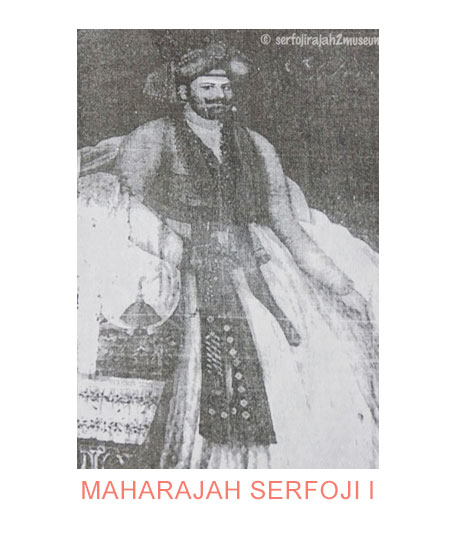MAHARAJAH SERFOJI I
Third King of Thanjavur, H.H. Cholasimhasanathipathi Srimant Rajasri Maharaja Kshatrapati Sri Serfoji I Raje Saheb Bhosle ruled Thanjavur from 1712–1728 A.D. After the death of King Shahaji II in 1712, he having no issue of his own was succeeded by his brother King Serfoji I, who was his representative at Shahakottai fort a few miles west of Kumbakonam, his other younger brother King Tukkoji was similarly a representative of King Shahaji at MahadevaPattinam fort near Mannargudi. King Serfoji I ruled Thanjavur with the help of his brother King Tukkoji. He followed his later brother King Shahaji II’s domestic policy and in foreign affairs he took part in the politics of Ramnad Sethupathi in a war of succession between the sons of Kizhavan Sethupathi of Ramnad. Serfoji I placed Bhavani Shankar on the throne and divided the Sethupathi’s territories into three parts, one taken by King Serfoji, the other to the Ramnad Sethupathi, while the third was made into a new zamindari of Sivaganga. The expendition to Ramnad was ably conducted by King Serfoji I’s general Ananda Raya Peshwa who served King Shahaji II previously and after King Serfoji I he served the last brother of King Shahaji II, King Tukkoji.
During his period the dam of Kallanai came into disrepair and King Serfoji I was prevented to carry out the repairs by Nayakas of Madura who had shifted to Trichy as their capital. King Serfoji I threatened invasion and then only the Nayak permitted King Serfoji I to carry out the repairs and avoided further famine in his country.
King Serfoji I was by nature pious and intensely religious and endowed agraharams like his brother, scholar King Shahaji at Thiruvenkadu, Mangamadam and at Serfojirajapuram in Thirukkadiyur. He was himself a scholar and patronised several scholars in his court. ‘Raghava Charitam’ is his work. Some noteworthy scholars of his court and their works are Bhagavant Raya’s Sachidananda Vilasa, Raghunatha’s Narakavarnam and Vittala’s Rukmini Swayamvara slokas, and all these three author’s works are in Marathi. Anandaraya Makhi, Vidaya Parinaya and Aswalayana Sutravrithi were his ministers. Anantha Narayana called by Serfoji I as Pancharatna Kavi wrote Gita Shankaram and Saraboji Charitam.

